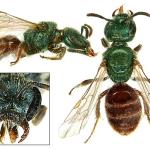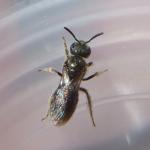Lasioglossum aeratum KIRBY 1802; Lasioglossum semiaeneum BRULLE 1832; Lasioglossum viridaeneum BLUTHGEN 1918
Although immediately recognisable as one of the small metallic green Lasioglossum bees, separation from the similarly-sized, and often more numerous, Lasioglossum morio requires a more detailed examination. The round face of the female and the white hind tarsi of the male should be sufficient to confirm L. leucopus.
Distributed throughout almost the entire British Isles, with records from the Outer Hebrides (Barra) in the north, to the Channel Islands in the south, and to Ireland in the west (where there are no recent records). The worldwide distribution is the northern Palearctic, with a montane bias in more southerly areas.
This bee is not regarded as being scarce or threatened.
Present in a wide variety of habitats.
Females may be found between May and October, males between July and September. As with all Lasioglossum in Britain, only mated females hibernate.
Although being a common and widely distributed species, nothing is known about its nesting habits apart from the fact that it nests in the ground.
Recorded visiting a wide variety of flowers from several plant families.
No records from Britain, although it is recorded as being parasitised by the bee Sphecodes geoffrellus in mainland Europe (Stockhert 1933; Westrich 1989). This is quite likely the case here as well.
2005



